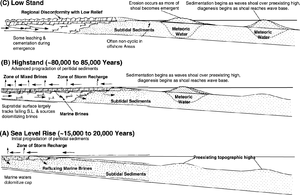Sea level cycles and carbonate diagenesis
| Exploring for Oil and Gas Traps | |

| |
| Series | Treatise in Petroleum Geology |
|---|---|
| Part | Predicting the occurrence of oil and gas traps |
| Chapter | Predicting reservoir system quality and performance |
| Author | Dan J. Hartmann, Edward A. Beaumont |
| Link | Web page |
| Store | AAPG Store |
Most of the diagenesis seen in carbonate rocks can be attributed to processes that occurred during short-term fourth- or fifth-order cycles (10–500 k.y) and, to a lesser extent, long-term third-order cycles (1–10 m.y). Early diagenesis that takes place during fourth- or fifth-order cycles can have a great deal of influence on the amount of paleohydrology and diagenesis that occurs during the longer term third-order cycles. For example, if porosity is occluded early, then later diagenesis does not occur or is greatly reduced because there is little or no pore-water movement.
High-frequency cycles
High-frequency sea level cycles (fourth or fifth order) cause the cyclical migration of the vadose, freshwater phreatic, and marine phreatic zones and the diagenetic processes occurring within those zones. Cycle amplitude and frequency determine the thickness and number of times a sequence is subjected to the processes that characterize each diagenetic zone. Each cycle leaves a diagenetic sequence mainly seen in the form of different cement types.[1]
Example

The diagram in Figure 1 shows the sequence of diagenetic events occurring in a prograding tidal flat during a high-frequency sea level cycle. Also shown are two pre-existing topographic highs that were propagated upward through the section by differential compaction. The stippled pattern represents limestone; the brick pattern is dolomite.
The following diagenetic processes occurred during this period.
- Time A occurs during rising sea level and is the beginning of the “keep-up” phase when the carbonate factory becomes established and progradation begins. Storm and tidal flooding of flats generate brines that dolomitize the laminite cap of the sequence.
- Time B is the highstand of sea level and represents advanced progradation. Updip, where there is no sedimentation, the supratidal surface becomes a disconformity. Refluxing brines dolomitize most of the inner platform section. Offshore, shoaling waves cause the deposition of ooid grainstones over the shallower pre-existing high. The shoal eventually emerges as it builds to sea level and a meteoric lens is established. Diagenesis of shoal sediments is mainly in marine and freshwater phreatic zones.
- Time C is the lowstand of sea level. A regional disconformity develops over the tidalflat laminites as they are subaerially exposed. Minor leaching occurs in the subtidal sediments as the result of an influx of meteoric water. The pre-existing high in deeper water is shallow enough for shoaling, and the same sequence occurs that took place earlier on the shallower pre-existing high. The shallower pre-existing high is now an island where diagenesis occurs in the vadose and phreatic zones. Its longer exposure causes greater diagenesis than occurs in the shoal over the deep pre-existing high.
Major unconformities that form as a result of uplift or third-order sea level lowstand can cause extensive diagenesis. In humid regions diagenesis can extend downdip for many miles and down section for hundreds to thousands of feet.[2] Early down-section water flow is diffusive, mainly moving through intergranular pores. Later, down-section water movement becomes dominated by conduit flow. The change in flow character is a result of plugging intergranular pores and leaching that widens joints and turns vugs into caves.
Reservoirs associated with long-term karsting tend to be highly compartmentalized[2] Vadose karst reservoirs tend to be of poor quality contrasted with phreatic reservoirs, which tend to be of high quality (Richard Fritz, personal communication). The amount of karstification decreases with decreasing rainfall. In very arid regions there may be relatively little diagenesis during emergence.
Dolomitization can occur during a subsequent transgression across the unconformity. The unconformity may be recognized in well logs by a high gamma ray count due to glauconite or uranium if the unconformity is covered by marine clastics or basinal facies.
See also
- Predicting carbonate porosity and permeability
- Carbonate facies
- Carbonate diagenetic stages
- Carbonate diagenesis
- Early carbonate diagenesis
- Basics of carbonate porosity formation and preservation
- Sea level cycles and carbonate sequences
- Sea level cycles and climate
- Sequences during low-amplitude, high-frequency cycles
- Sequences during moderate-amplitude, high-frequency cycles
- Sequences during high-amplitude, high-frequency cycles
- Predicting carbonate reservoir location and quality
References
- ↑ 1.0 1.1 Read, J., F., 1995, Overview of carbonate platform sequences, cycle stratigraphy and reservoirs in greenhouse and ice-house worlds, in Read, J., F., Kerans, C., Webber, L., J., Sarg, J., F., Wright, F., M., eds., Milankovitch Sea-level Changes, Cycles, and Reservoirs on Carbonate Platforms in Greenhouse and Ice-house Worlds: SEPM Short Course 35, 183 p. Good summary of concepts of climatic effect on sea level cycles, carbonate deposition, and reservoir development.
- ↑ 2.0 2.1 Read, J., F., Horbury, A., D., 1993, Eustatic and tectonic controls on porosity evolution beneath sequence-bounding unconformities and parasequence disconformities on carbonate platforms, in Horbury, A., D., Robinson, A., G., eds., Diagenesis and Basin Development: AAPG Studies in Geology 36, p. 155–197.